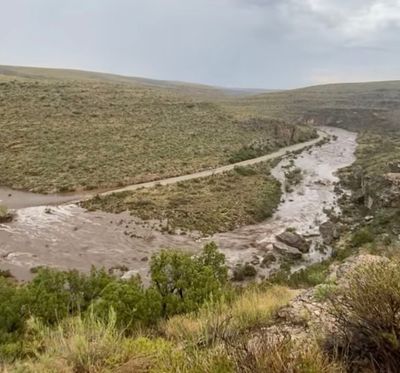Flash floods at national parks strand 200, leave hiker missing

One person who had been hiking Friday at a national park in Utah remained missing Sunday and about 200 people at a national park in New Mexico were trapped for several hours Saturday amid heavy rain and flash flooding in parts of the Southwest.
At Zion National Park in Utah, a flash flood Friday afternoon swept multiple hikers off their feet in the Narrows, a popular section of Zion canyon that requires wading in the Virgin River. At least one person was swept downstream and injured, and several others were able to find high ground and were rescued by emergency responders, the National Park Service said.
But later that evening, friends reported Jetal Agnihotri of Tucson, Arizona, missing. She has not returned from hiking in the Narrows, the park service said. Her brother, Pujan Agnihotri, told KSLTV that his sister could not swim.
Portions of the park remained closed Sunday, according to its website.
On Saturday, in New Mexico, visitors at Carlsbad Caverns National Park were forced to shelter in place for more than nine hours because flooded roads became impassable, according to the Eddy County Office of Emergency Management.
Authorities said that they responded to calls of visitors who attempted to cross streams and became stuck in their cars. Noting that water just 1 foot high can sweep away vehicles, emergency responders on Facebook repeated the mantra of the weekend to drivers: “Turn around, don’t drown.”
Jennifer Armendariz, the emergency manager for Eddy County, said officials had conducted a few rescues, including for a family whose vehicle had turned on its side and a couple stranded on the roof of their car. No injuries were reported.
Armendariz said educating the public about not crossing streams in vehicles during a flood was a constant challenge. Although water may not always look deep, it’s “not worth the risk of trying to cross,” she said, adding that a man in the county had died last year in such a situation.
“I believe it was a Jeep of some sort that was a little lifted off the ground so he felt he was above the water enough to be able to pass through it,” she said. “Unfortunately, it picked up the vehicle and took him.”
An order to shelter in place at Carlsbad Caverns was lifted late Saturday, and about 200 visitors and staff members were evacuated, she said. On Sunday, crews began clearing debris from the roadway.
Monsoonal moisture is contributing to more frequent showers and thunderstorms, the National Weather Services in Utah and New Mexico said. A monsoon is a seasonal change in winds that can result in increasing humidity levels over land, triggering more frequent storms, according to the weather service.
From the Southern Plains into the lower Mississippi River Valley, heavy rains were expected to continue into the week, with a continued threat of flash flooding, the weather service said.
On Sunday, more than 100,000 people in the United States were under flash flood watches, according to weather service data.
National parks in southern Utah remained under elevated risk of flash flooding Sunday, the weather service in Salt Lake City said.
Flash floods do not only occur in areas near bodies of water. They can surge anywhere that experiences intense rainfall over a brief period of time. As the climate warms, researchers expect that flash floods will increase and get “flashier,” resulting in shorter but more intense flooding.
This article originally appeared in The New York Times.